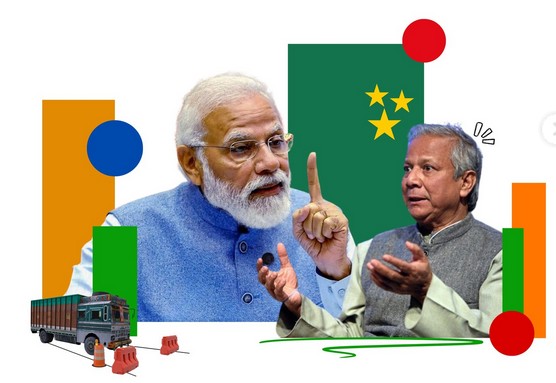N4S
India‑Bangladesh ties shift from warmth to worry, trade to tension, diplomacy to dilemmas. UPSC usually throws a big‑picture question that links neighbourhood politics with wider security, just as it asked in 2017 about China’s trade surplus turning into military clout; a similar mains prompt could use “The 2025 Flashpoint: From Cooperation to Confrontation” to test how you weigh trade bans against strategic fallout. Many aspirants stumble because they list facts but miss the chain of cause‑and‑effect across subheads like “Key Aspects of India‑Bangladesh Trade Relations” and “Impact of Geopolitical Issues on India’s Trade with Neighbours,” leaving answers scattered and shallow. This article fixes that by walking you through the logic—first it shows why Dhaka’s China tilt alarms Delhi (see “Geopolitical Realignment Toward China and Pakistan”), then it maps the spill‑over into anti‑India sentiment and Northeast security worries (under “Implications for India”). The most special part is its blueprint for solutions in “Using Multi‑Vector Diplomacy to Reset India‑Bangladesh Ties,” which turns theory into ready‑to‑use policy ideas—like pairing UPI payments with border haats or talking to both BNP and grass‑roots groups—so you can plug gaps that UPSC loves to probe.
PYQ ANCHORING
GS 2: ‘China is using its economic relations and positive trade surplus as tools to develop potential military power status in Asia’, In the light of this statement, discuss its impact on India as her neighbor.[2017]
MICROTHEMES: Groupings involving Immediate and Extended neighbours
India and Bangladesh have historically shared a strong and multifaceted relationship, particularly flourishing since the Awami League came to power under Sheikh Hasina in 2009. This partnership has brought political goodwill, strategic cooperation, and deep economic ties. India became Bangladesh’s second-largest trading partner, exporting machinery, vehicles, and raw materials, while importing garments, fish, and jute products from its neighbour.
Beyond trade, the two countries collaborated on key infrastructure and connectivity projects such as the Akhaura–Agartala rail link, the India-Bangladesh power grid, the Maitree Setu bridge, and cross-border energy pipelines. These projects not only enhanced economic integration but also helped stabilise India’s Northeast by improving connectivity and fostering people-to-people ties.
The 2025 Flashpoint: From Cooperation to Confrontation
In 2025, the bilateral relationship took a sharp turn when India imposed trade restrictions on Bangladeshi goods, notably readymade garments. This marked a clear shift from cooperation to confrontation, triggered by growing unease over Bangladesh’s internal political developments and its external alignments.
Three key developments prompted India’s reaction:
1. Geopolitical Realignment Toward China and Pakistan:
The interim Bangladeshi government, led by Mohammed Yunus, has been perceived by India as pivoting towards China and Pakistan. A notable flashpoint was Yunus’s invitation to China to access India’s Northeast through Bangladesh—a move seen in Delhi as a direct challenge to India’s strategic interests.
2. Provocative Comments About Northeast India:
Yunus described India’s Northeast as “landlocked” and implied that Bangladesh served as its essential gateway. This narrative was interpreted as undermining Indian sovereignty and portraying Bangladesh as a leverage-holding power over a geopolitically sensitive region.
3. Democratic Backsliding in Dhaka:
India was also alarmed by domestic political developments. The interim regime banned the Awami League and indefinitely postponed elections—moves that India saw as undemocratic. The trade restrictions were also intended as a signal of disapproval and an assertion of normative pressure.
Implications for India: More Than Just Trade
The diplomatic rupture has wider ramifications for India:
1. Rising Anti-India Sentiment in Bangladesh:
Trade restrictions may be perceived within Bangladesh as punitive and politically motivated, potentially fuelling anti-India rhetoric, particularly among nationalist and radical segments.
2. Security Instability in the Northeast:
Any political or economic instability in Bangladesh could spill over into Indian territory in the form of refugee influx, cross-border tension, or even radicalisation in sensitive areas like Assam and Tripura.
3. Loss of Diplomatic Influence:
By limiting economic engagement, India also risks reducing its soft power and losing valuable diplomatic space. In a region where influence often rides on connectivity and aid, such restrictions can narrow India’s options for dialogue.
Key Aspects of India-Bangladesh Trade Relations// PRELIMS
1. Trade & Economic Exchange
- In 2023–24, bilateral trade stood at $14.01 billion.
- India’s main exports: electricity, cotton yarn, refined petroleum.
- Bangladesh’s top exports: garments (e.g., men’s suits), textile scraps, and even some aircraft components.
- Both countries view each other as critical trade partners.
2. Investment & Infrastructure
- Indian investments in Bangladesh are steadily growing, especially in energy and infrastructure.
- Initiatives like the Protocol on Inland Waterways Trade and Transit (PIWTT) and access to Chittagong and Mongla Ports are enhancing regional connectivity.
3. Security & Strategic Cooperation
- Joint efforts include managing borders, tackling cross-border crime, and regular military exercises like SAMPRITI and MILAN.
- Both nations align on sub-regional maritime goals, including Indo-Pacific cooperation and ocean economy development.
4. Cultural & People-to-People Ties
- Institutions like the Indira Gandhi Cultural Centre and Indian Cultural Centre in Dhaka promote cultural and educational exchange.
5. Emerging Trends
- Trade and investment are on a steady rise, deepening economic interdependence.
- This growing interlinkage contributes to shared prosperity and regional stability.
Impact of Geopolitical Issues on India’s Trade with Neighbours
India’s trade with its neighbours is deeply intertwined with regional geopolitics. While geography offers natural trade advantages, political tensions often override economic logic. Border disputes, shifting alliances, and domestic instability in neighbouring countries routinely disrupt trade flows, stall infrastructure projects, and limit market access. The following table highlights how geopolitical issues have directly impacted India’s trade with each of its key neighbours.
| Neighbour | Geopolitical Issue | How Trade is Affected | Example |
| China | Border tensions (e.g. Galwan clash, 2020), trust deficit | Rise in tariffs, curbs on Chinese investments, non-tariff barriers | Post-Galwan, India banned 200+ Chinese apps, restricted Chinese firms in infrastructure and telecom sectors. Imports slowed, especially in electronics and machinery. |
| Pakistan | Cross-border terrorism, Pulwama attack, no MFN status | Complete trade suspension; loss of cross-border trade routes | After Pulwama (2019), India withdrew MFN status and imposed 200% duty; Pakistan responded by suspending all trade ties. |
| Bangladesh | Shift in foreign policy, tilt towards China, election-related tensions | Imposition of trade restrictions, loss of access routes | In 2025, India restricted readymade garment imports over Dhaka’s perceived China tilt and comments on Northeast India. |
| Nepal | Map dispute (Kalapani-Lipulekh), growing Chinese presence | Strain on bilateral infrastructure and logistics cooperation | 2020 map row led to tensions; projects like India-Nepal railway and hydro deals slowed; pro-China tilt in Kathmandu affected trust. |
| Sri Lanka | Chinese debt trap diplomacy, strategic port control (Hambantota) | Reduced Indian influence in maritime trade routes, delay in key Indian projects | Chinese control of Hambantota port raised Indian security concerns; India lost competitive edge in some logistics and energy projects. |
| Myanmar | Political instability post-coup, Chinese influence | Connectivity projects disrupted; security risks for trade corridors | India’s Kaladan Multi-Modal Transit project slowed down; insurgency spillovers affected border trade via Mizoram and Manipur. |
| Afghanistan | Taliban takeover, lack of direct land access via Pakistan | India lost major export market; stalled infrastructure and trade deals | After 2021 Taliban takeover, Indian wheat and pharma exports halted; access blocked as Pakistan denied land route. |
Need Of Multi-Vector Diplomacy For India //MAINS
Multi-vector diplomacy simply means not putting all your eggs in one basket when dealing with another country. Instead of relying on just one type of connection (like only government-to-government talks or only trade), you build many kinds of relationships at the same time — with:
- Government (ruling and opposition),
- Businesses and traders,
- People and culture,
- Universities and tech sectors,
- Media, youth, and civil society.
So, even if one door closes, you still have other doors open to keep the relationship strong.
India‘s Experience with Multi Vector diplomacy
India has repeatedly practised “multi-vector diplomacy,” using several parallel channels (security, economy, technology, people-to-people) and partnering with rival blocs at the same time. Below are headline-worthy examples from the last few years.
| What India Did | Why It Counts as Multi-Vector |
| Kept the Russia lifeline open—cheap oil, strategic trade- even while deepening its “Comprehensive Global Strategic Partnership” with the United States (iCET tech pact, critical-minerals supply chains, joint fighter-jet engines). | Shows India’s willingness to ring-fence energy & defence ties with Moscow while courting U.S. tech and investment—two opposite “vectors” managed simultaneously. |
| Sits in the Quad and hosts the Shanghai Cooperation Organisation (SCO).Quad summits (2021-24) shape Indo-Pacific rules with the U.S., Japan & Australia.India chaired the 2023 SCO summit—an organisation led by China & Russia—and refused to sign the BRI clause while pushing digital payments and counter-terror statements. | Demonstrates the “two chairs, one table” tactic—maritime security with the West, continental security with Eurasia—without choosing sides. |
| Championed BRICS expansion in 2023 & 2024 and launched the Voice of Global South Summits during its G-20 presidency. | Runs with a China- and Russia-heavy club (BRICS) while positioning itself as spokesperson for 100+ developing countries—two very different coalitions, one Indian bridge. |
| Middle-East balancing act:Joined the I2U2 mini-lateral (India, Israel, UAE, U.S.) on food & green-energy corridors.Votes variously at the U.N.—backing a Gaza cease-fire in Dec 2023, abstaining on an HRC arms-embargo vote in Apr 2024—while remaining a top defence-tech partner of Israel. | Keeps defence tech flowing from Israel, gains Gulf capital for food-energy projects, and preserves goodwill in the Arab street—three vectors in one theatre. |
| Crisis-manager in Sri Lanka—co-chaired the Paris creditors’ platform with Japan & France, gave ~$4 billion credit lines, and rolled out UPI digital payments there. | Engages finance (debt relief), development (credit & fuel), and fintech (UPI link)—showing how India mixes soft-power tools with hard cash to keep China at bay. |
| Signed on to the India–Middle East–Europe Economic Corridor (IMEC) while still pushing the older International North-South Transport Corridor (via Iran-Russia). | Bets on both a U.S./Saudi-led supply route and an Iran-Russia route, diversifying geography as well as partners. |
Using Multi-Vector Diplomacy to Reset India-Bangladesh Ties
| Vector | What India Should Do | Why It Works |
| Political Engagement | Engage not just the ruling party (Awami League), but also BNP, emerging parties, reformist groups, and local influencers. | Prevents over-dependence on one regime and ensures continuity in ties despite leadership changes. |
| People-to-People Ties | Scale up border haats, youth exchanges, cultural scholarships, tourism, and education links. | Builds public goodwill, which cushions political friction and generates long-term trust. |
| Trade + Transit + Tech | Bundle trade deals with digital payments (UPI), logistics upgrades, and cross-border power grid projects. | Deepens economic interdependence, making disruption costly for both sides. |
| Soft Power Diplomacy | Offer India’s digital stack, language training, medical support, media collaboration, and disaster management capacity. | Offers Bangladesh value China can’t replicate—culturally aligned, people-centric development tools. |
| Regional Multilateralism | Use BBIN, BIMSTEC and SAARC-like forums to promote joint projects and regional rules. | Shifts the conversation from bilateral blame-games to shared regional goals and norms. |
When a relationship feels stuck, don’t push harder in one direction—open more lanes. Multi-vector diplomacy gives India the tools to engage with Bangladesh across society, not just state, ensuring that ties are resilient, not reactive.
Conclusion
Geography may make neighbours, but smart diplomacy makes them partners. India’s trade with its neighbours has often been hostage to shifting politics, border tensions, and third-party influence. To insulate economic ties from such volatility, India must adopt a broader, multi-vector diplomatic approach—engaging not just governments but also opposition parties, civil society, and regional platforms. In a geopolitically sensitive neighbourhood, resilience in trade will come not from rigid alliances but from flexible, layered diplomacy.
#BACK2BASICS: India–Bangladesh Relations: A Test Case of Neighbourhood Diplomacy
India and Bangladesh share more than a 4,000-km border — they share history, culture, rivers, language, and bloodshed during the 1971 Liberation War. Since then, the relationship has been described as both “tested” and “transformational.” While cooperation has grown in trade, connectivity, and security, sensitive issues like migration, water-sharing, and border tensions continue to stir political emotions on both sides.
Key Pillars of the Relationship
| Area | Cooperation/Developments |
| Historical Ties | India supported Bangladesh’s independence in 1971, hosting over 10 million refugees and intervening militarily. |
| Trade & Economic Cooperation | India is Bangladesh’s second-largest trade partner. Bangladesh is India’s biggest trade partner in South Asia. Trade crossed $18 billion (2022). |
| Connectivity & Infrastructure | Projects like BBIN (Bangladesh-Bhutan-India-Nepal), cross-border railways (Kolkata–Khulna), and waterways revive pre-Partition connectivity. |
| Energy Cooperation | India supplies 1,160 MW electricity to Bangladesh. Adani’s power export deal, and a growing clean energy focus signal deeper energy diplomacy. |
| Security & Counterterrorism | Bangladesh has cracked down on anti-India insurgents. Joint efforts on border management, terror control, and intelligence-sharing have improved. |
| Cultural & People-to-People Ties | Exchange of language, films, tourism, and festivals reinforces soft power and cultural proximity. |
Irritants & Contentious Issues
| Issue | Explanation |
| Teesta Water Sharing | Long-pending treaty over sharing Teesta river water is stalled due to opposition from West Bengal government. |
| Illegal Migration | Assam and border states raise concerns over illegal migration; politicised in domestic Indian politics, especially around NRC-CAA debates. |
| Border Killings | Despite coordination, incidents of civilian killings by BSF remain a sore point. India claims anti-smuggling action; Bangladesh calls for restraint. |
| China Factor | Bangladesh has growing defence and infrastructure ties with China, creating strategic anxiety for India. |
| Rohingya Issue | Bangladesh seeks stronger Indian support for Rohingya repatriation from its territory to Myanmar. India walks a fine line to balance regional ties. |
Recent High Points
- Maitri Setu (Friendship Bridge) opened in Tripura to boost Northeast–Bangladesh connectivity.
- CEPA (Comprehensive Economic Partnership Agreement) discussions underway for deeper trade integration.
- Joint River Commission revived; cooperation on over 50 shared rivers being negotiated.
- India supplied COVID vaccines under Vaccine Maitri and extended credit lines for infrastructure projects.
Way Forward
- Finalise Teesta and other water-sharing deals transparently and equitably.
- Expand regional trade zones and speed up CEPA to deepen economic interdependence.
- Engage Bangladesh more actively in BIMSTEC and Indo-Pacific strategies.
- Jointly tackle border crimes through tech-based surveillance and people-friendly protocols.
- Respect domestic political sensitivities, particularly in West Bengal and Dhaka, to avoid diplomatic frictions.
- Counterbalance China’s influence through timely delivery of projects and concessional funding.
Conclusion
India–Bangladesh relations represent the most stable and promising bilateral equation in South Asia, but they require constant nurturing. From liberation partners to strategic partners, the two countries have come a long way — and with political will, they can emerge as a model for regional cooperation in a turbulent neighbourhood.
SMASH MAINS MOCK DROP
In the context of recent downturns in India–Bangladesh relations, critically analyse how India’s trade policy and geopolitical responses to shifting alignments in its neighbourhood can either deepen regional stability or fuel strategic anxieties. Can multi-vector diplomacy offer a sustainable path forward?


